 web3.0
web3.0
 From liquidity staking to re-staking innovation, how does Persistence affect the Cosmos ecosystem?
From liquidity staking to re-staking innovation, how does Persistence affect the Cosmos ecosystem?
From liquidity staking to re-staking innovation, how does Persistence affect the Cosmos ecosystem?
Persistence one ($XPRT) is one of the first Cosmos application chains to enable IBC, CosmWasm and Liquidity Staking Module (LSM). By continuing to develop POS and liquidity staking related products, we have built a liquidity staking and re-staking structure for the Cosmos ecosystem.
On December 5, 2023, the Cosmos community voted to allocate 600,000 ATOM to pSTAKE for liquidity staking growth. pSTAKE shares 15% of liquidity staking revenue with Cosmos Hub.
Persistence
Ecology
Map of Zones visual data chart, you can see the influence of Persistence in the Cosmos ecology:
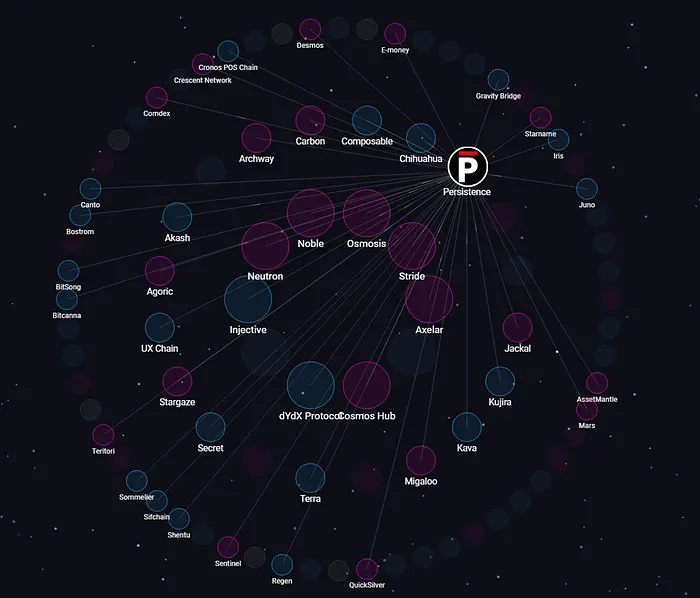
According to the official website data, the Persistence ecological TVL is US$14.78 million, the IBC transaction volume in the past 30 days is US$15 million, and the average transaction cost is less than US$0.005.

Map of Zones data shows that the Persistence.one zone has established 121 channels with 44 other zones in the Interchain network. This shows that it is a highly interconnected node, capable of interacting with many other areas through multiple channels.
74.7% of the network tokens ($XPRT) are staked. A higher pledge rate usually indicates that the network has higher security and participation enthusiasm. The annualized return on staking is 16.7%.
Persistence’s infrastructure consists of 6 nodes and 100 validators, which jointly ensure the decentralization and security of the network.
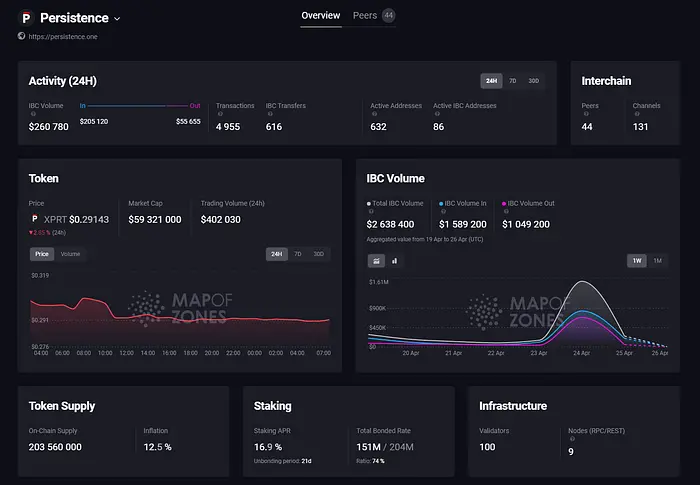
In the above ecological data, IBC (Inter-Blockchain Communication) is a core protocol of the Cosmos ecosystem, used to achieve interoperability between different blockchains. Through IBC, independent blockchains can seamlessly transfer tokens and other data types, making it possible to build cross-chain applications. IBC transaction volume reflects the scale of value inflow and outflow between the Persistence chain and the outside world.
In the past 24 hours, Persistence’s IBC trading volume was US$260,800. The number of transactions was 4,955, including 616 IBC transactions. There are 932 active addresses and 86 IBC active addresses. Among them, the inflow of IBC continues to be higher than the outflow, which should mean that more and more value flows into Persistence and participates in staking.
The pledge platform pSTAKE is the Persistence chain and an important product of the Cosmos ecosystem.
Technical Support
Persistence supports the CosmWasm framework, allowing developers to write secure and interoperable smart contracts in the Rust language. In addition, DApps developed using the CosmWasm framework can run cross-chain through IBC to achieve cross-chain interoperability of applications, providing convenient, safe and efficient technical support for liquidity staking.
Persistence is connected to 54 Cosmos application chains through IBC for trustless communication, transfer, pledge and re-pledge of tokens, laying an ecological foundation for Cosmos ecological pledge and re-pledge.
Use Interchain Accounts (ICA) to implement ICA Liquid Staking. Interchain Accounts allow accounts on one chain to perform operations on another chain, enhancing the efficiency and flexibility of staking and re-staking.
Liquidity Staking
Cosmos Ecological Staking and Network Security
In the Ethereum ecosystem, the threshold for verification nodes is to pledge more than 32 ETH. Liquid staking platforms such as Lido allow users to pledge small amounts of ETH, aggregate these pledged funds, and distribute them to verification node operators in units of 32 ETH, thus promoting the increase in the number of Ethereum verification nodes and helping Enhance the security and decentralization of the Ethereum network.
In the Cosmos ecosystem, liquidity staking includes two roles – validator and principal.
The pledger, that is, the principal, can choose the entrusted validator node when pledging.
Validators run hardware and blockchain applications based on the Cosmos SDK to reach consensus with other validators to propose and validate new blocks on the chain.
If the verifier behaves negatively, the principal of the verifier node will be punished accordingly. If a validator engages in inappropriate behavior, including accidental or malicious continued offline activity, the principal's pledged deposit will be destroyed or reduced by 0.1%. If a validator engages in extremely malicious behavior, such as a double-signing violation where a validator signs a given block more than once, the staked deposit will be reduced by 5%.
It can be seen that the essence of Cosmos ecological liquidity staking is to prevent malicious behavior through economic incentives and potential penalties. Verifiers and delegators share the responsibility to maintain network efficiency and security, while receiving certain token rewards.
pSTAKE Staking
pSTAKE ($PSTAKE) is one of the portfolios of Binance Labs and Coinbase ventures
.
pSTAKE provides a simple staking process for the Cosmos ecosystem. Users only need to select the pledged token and the chain it belongs to to pledge.
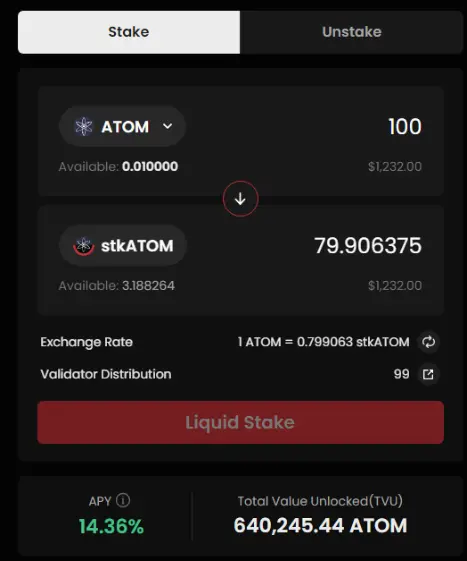
#After the pledge is completed, the pSTAKE protocol issues the corresponding pledge equity tokens to the wallet. For example, if you pledge ATOM, you can get stkATOM.
Automatic compound interest
Taking stkATOM as an example, the user’s daily staking income is ATOM, which will automatically enter the pledge and continue to receive income. After the income enters the pledge, this means that the pledged ATOM corresponding to each stkATOM increases, and users can obtain more ATOM when unstaking. Therefore, the user's staking income shows an increase in the ratio of stkATOM/ATOM.
Unstaking
When users cancel their pledge, they need to wait 21 to 25 days; they can also pay a 1% fee to cancel the pledge in a flash. When the user withdraws the pledge, the corresponding stk assets are destroyed.
Pledge yield
The assets supported by pSTAKE pledge and the current yield are as follows:
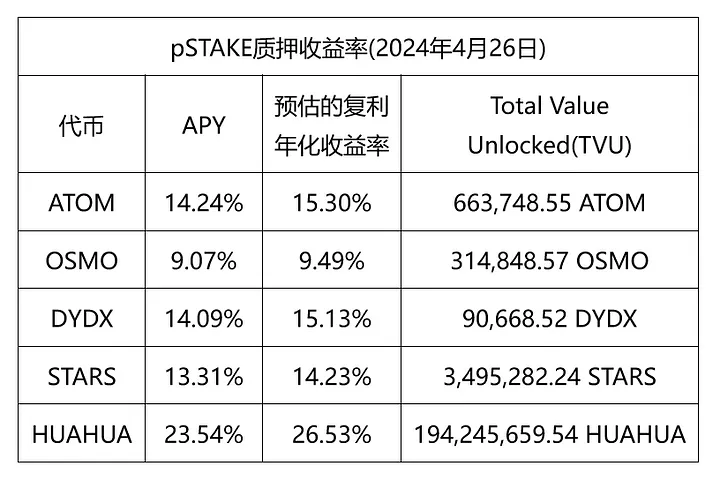
Among them , the estimated compound interest annualized rate of return remains unchanged at the day's rate of return and is calculated based on compound interest.
Notes
pSTAKE currently supports ATOM on the Cosmos Hub, OSMO on the Osmosis chain, DYDX on the dYdX chain, STARS on Stargaze, HUAHUA on Chihuahua, and on the Persistence chain These 5 tokens are minted.
When the user chooses the native chain to pledge tokens, pSTAKE pledge goes through two steps. The assets are cross-chained to the Persistence chain through IBC, and then the liquidity staking module of the Persistence chain is called to pledge the assets.
Therefore, on pSTAKE, no matter which chain's assets are pledged, a certain amount of the base token of the Persistence chain - $XPRT - is required as GAS. Of course, the GAS of the Persistence chain is very low.
Pledge Derivatives
Persistence and even the Cosmos ecosystem have launched more stk asset derivatives.
For example, in DEX products, stkATOM can be directly exchanged for ATOM without unstaking or paying a 1% fee. Moreover, the combination of stk assets and native assets can also add liquidity to DEX and obtain higher returns. For example, in Dexter owned by Persistence, the expected annualized return of stkDYDX DYDX is 45.82%.
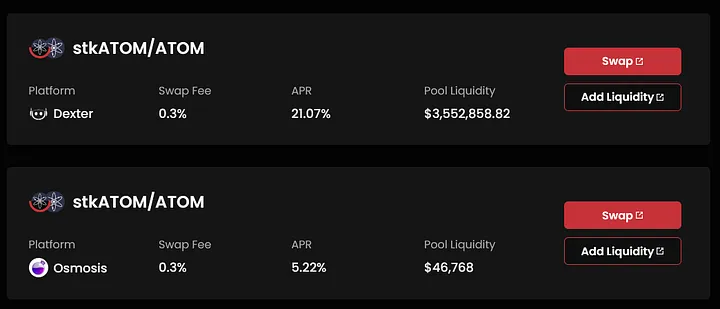
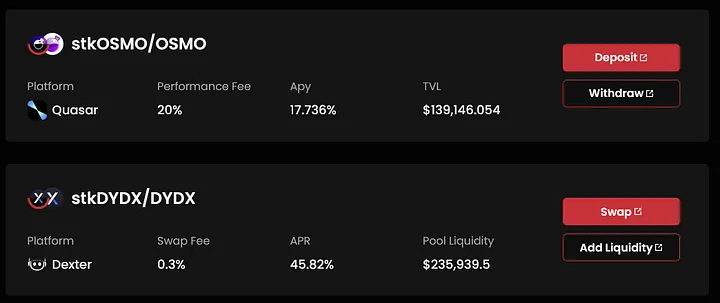

$XPRT Staking
Persistence as an independent blockchain , also requires staking to improve network security.
You can easily pledge $XPRT in the Persistence official or keplr wallet.
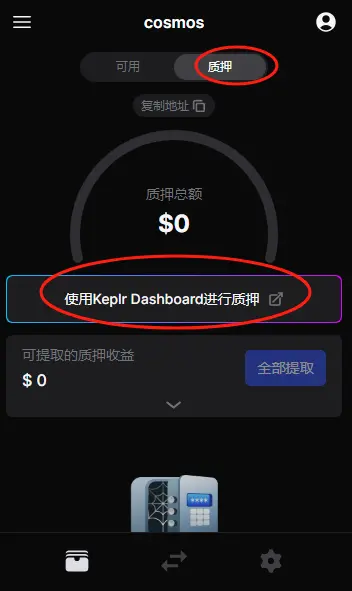
After selecting the Persistence network, select the verification node you want to pledge to stake $XPRT.
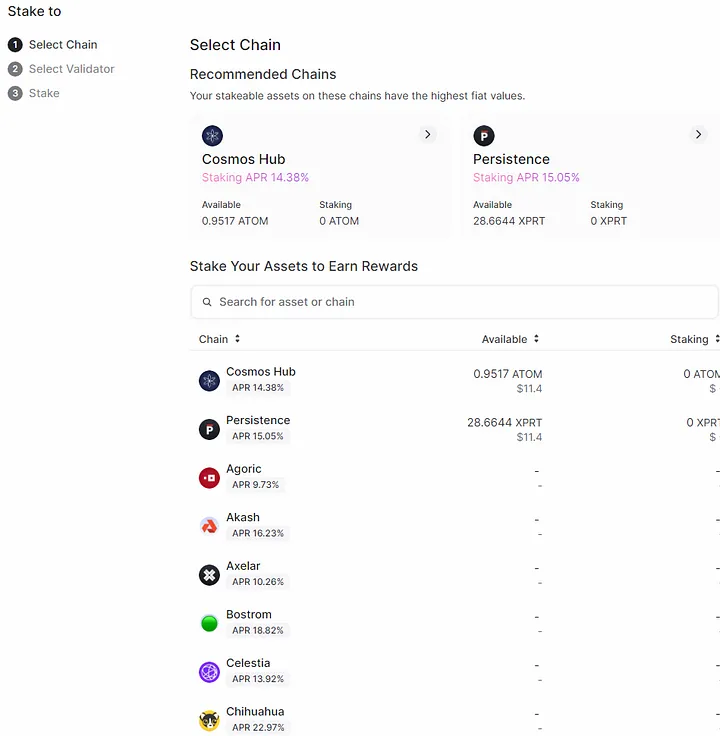
Staking security
As a liquidity staking platform, Persistence is an important cornerstone of the Cosmos ecological security.
Persistence and pSTAKE are both open source programs, which is one of the guarantees of security. Among them, the pSTAKE program came from the participation of 72 developers, and the most recent code submission was 2 days ago.
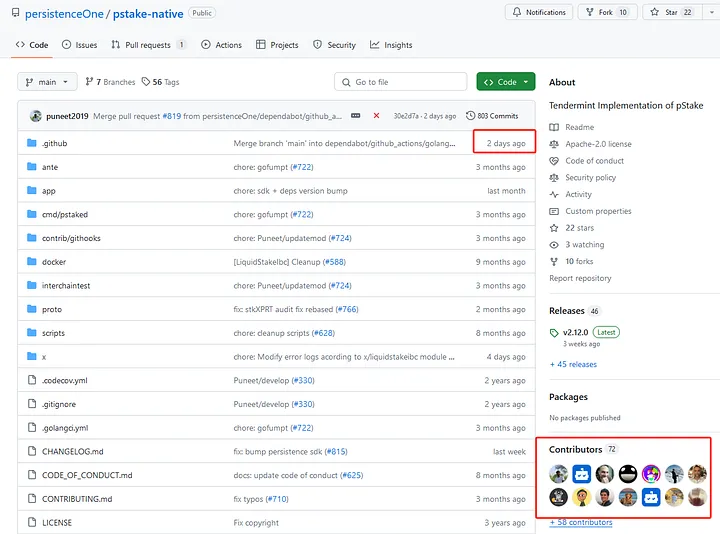
Moreover, Persistence and pSTAKE cooperate with a number of security agencies to provide comprehensive support for the security of staking and re-pledge. These security agencies include:
•Well-known blockchain and encryption security and audit institutions: Halborn, PeckShield, Certora, Hexens and Notional;
•Global security research and consulting company: Trail of Bits;
•Smart contract and related security auditing and consulting organizations: Solidified, ConsenSys Diligence, Oak Security;
•DeFi’s leading bug bounty platform: Immunefi.
•Blockchain security real-time monitoring and alarm network: Forta.
Restaking
According to the Persistence blog, the project team is building the Restaking infrastructure in Cosmos, allowing users to transfer liquid staking tokens (stkATOM, stTIA, stkDYDX through pSTAKE, Stride, Quicksilver etc.) into Persistence. This allows them to re-stake their assets and secure additional chains while earning additional rewards.
Persistence re-pledge module supports pledge requests for multiple assets, such as pledged equity tokens, stable coins, LP tokens, etc.
Re-Pledge Alliance
Persistence’s re-pledge module is developed based on the Alliance module. Alliance is an open source Cosmos SDK module built by Terraform Labs that enables assets to be pledged from one blockchain to another, using inter-chain staking to enable blockchains to form mutually beneficial relationships.
For example, the pledgers of $XPRT, stkATOM and stkTIA joined Persistence's re-pledged asset alliance after pledging the corresponding assets in Persistence respectively. Stakeholders of stkATOM and stkTIA can receive re-staking rewards and $XPRT.
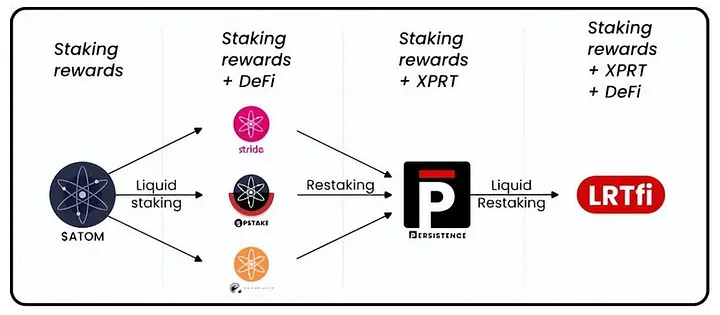
The re-pledge alliance shares the staking income. Pledgers of various assets are distributed according to the reward weight of the assets. The reward weight of $XRPT is 1, and the reward weights of other assets are determined and adjusted through decentralized governance.
For example, the reward weights of stkATOM and stkTIA are 0.4 and 0.2 respectively. Assuming that there are only $XPRT, stkATOM and stkTIA in the re-pledge asset alliance, then the reward ratios of the pledgers of these three assets are:
$XPRT: 1/(1 0.4 0.2)=62.5%
stkATOM: 0.4/(1 0.4 0.2)=25%
stkTIA: 0.2/(1 0.4 0.2)=12.5%
Persistence, a pledged asset alliance reward distribution mechanism, forms an alliance of re-pledged assets and forms a community of interests, which is conducive to improving the security and decentralization of the Cosmos ecological chain.
Source of re-pledge income
The tokens used by users for re-pledge will be locked, and the native tokens will be minted in proportion, and the minted native tokens will enter the pledge module for delegation The human role is pledged to the validator.
For example, the stkATOM and stTIA pledged by users will be locked by the re-pledge module on the Persistence chain, and $XPRT will be minted in proportion. These $XPRT will be pledged to the verifiers, and the staking income will be distributed to pledgers such as tkATOM and stTIA.
This is the source of income from Persistence re-pledge, and it also further strengthens the security and liquidity of the Cosmos ecological chain.
Written at the end
Persistence chain provides an effective and secure
economic infrastructure for the liquidity staking and re-pledge of the Cosmos ecosystem. Through liquidity staking products, Persistence is gradually deepening its influence in the Cosmos ecosystem and bringing higher security, asset liquidity and ecological participation to the ecosystem.
Persistence establishes an economic alliance for re-pledgers through innovative re-pledge solutions. This alliance allows re-pledgers to form a cross-chain community of interests, which not only enhances mutual security, but also improves the decentralization of the Cosmos ecological chain in the re-pledge alliance.
The above is the detailed content of From liquidity staking to re-staking innovation, how does Persistence affect the Cosmos ecosystem?. For more information, please follow other related articles on the PHP Chinese website!

Hot AI Tools

Undresser.AI Undress
AI-powered app for creating realistic nude photos

AI Clothes Remover
Online AI tool for removing clothes from photos.

Undress AI Tool
Undress images for free

Clothoff.io
AI clothes remover

Video Face Swap
Swap faces in any video effortlessly with our completely free AI face swap tool!

Hot Article

Hot Tools

Notepad++7.3.1
Easy-to-use and free code editor

SublimeText3 Chinese version
Chinese version, very easy to use

Zend Studio 13.0.1
Powerful PHP integrated development environment

Dreamweaver CS6
Visual web development tools

SublimeText3 Mac version
God-level code editing software (SublimeText3)

Hot Topics
 A detailed introduction to virtual currency is a must-read for novices
Apr 24, 2025 pm 01:33 PM
A detailed introduction to virtual currency is a must-read for novices
Apr 24, 2025 pm 01:33 PM
Virtual currency is a digital asset encrypted using cryptography technology, with its main features including decentralization, encryption security, global circulation and relative anonymity. Virtual currency has a wide range of application scenarios, including value storage, trading media, investment and financial management, DeFi, NFT, blockchain games, smart contracts, dApps and governance voting. Participating in virtual currency requires 1) Learn basic knowledge, 2) Select a trading platform, 3) Register and verify your identity, 4) Purchase virtual currency, 5) Safely store, 6) Participate in the community. Investments need to pay attention to risks such as price fluctuations, market, technology, supervision, fraud and information asymmetry.
 Which of the top ten currency trading platforms in the world are the latest version of the top ten currency trading platforms
Apr 28, 2025 pm 08:09 PM
Which of the top ten currency trading platforms in the world are the latest version of the top ten currency trading platforms
Apr 28, 2025 pm 08:09 PM
The top ten cryptocurrency trading platforms in the world include Binance, OKX, Gate.io, Coinbase, Kraken, Huobi Global, Bitfinex, Bittrex, KuCoin and Poloniex, all of which provide a variety of trading methods and powerful security measures.
 What are the top ten virtual currency trading apps? The latest digital currency exchange rankings
Apr 28, 2025 pm 08:03 PM
What are the top ten virtual currency trading apps? The latest digital currency exchange rankings
Apr 28, 2025 pm 08:03 PM
The top ten digital currency exchanges such as Binance, OKX, gate.io have improved their systems, efficient diversified transactions and strict security measures.
 What currency does Ripple (XRP currency) belong to? Detailed tutorial for beginners
Apr 28, 2025 pm 07:57 PM
What currency does Ripple (XRP currency) belong to? Detailed tutorial for beginners
Apr 28, 2025 pm 07:57 PM
Created by Ripple, Ripple is used for cross-border payments, which are fast and low-cost and suitable for small transaction payments. After registering a wallet and exchange, purchase and storage can be made.
 The best free virtual currency exchange in the world Free newbie virtual currency exchange app
Apr 24, 2025 pm 12:57 PM
The best free virtual currency exchange in the world Free newbie virtual currency exchange app
Apr 24, 2025 pm 12:57 PM
The best free virtual currency exchanges in the world are Binance, OKX and Gate.io. 1. Binance provides an efficient trading system and rich trading pairs, simple registration, and supports multiple cryptocurrency transactions. 2. OKX is famous for its technical support and customer service, and provides a variety of transaction methods. 3. Gate.io attracts newbies with rich trading pairs and free services, with a simple interface and supports multiple languages.
 Top 10 virtual currency app rankings Recommended by the top ten virtual currency app trading platforms in 2025
Apr 28, 2025 pm 04:12 PM
Top 10 virtual currency app rankings Recommended by the top ten virtual currency app trading platforms in 2025
Apr 28, 2025 pm 04:12 PM
Top 10 virtual currency app rankings: 1. OKX, 2. Binance, 3. gate.io, 4. Coinbase, 5. Kraken, 6. Huobi, 7. Bitfinex, 8. KuCoin, 9. Bitstamp, 10. Gemini, these exchanges are known for their efficient trading systems, rich trading pairs and multiple security measures to meet the needs of different users.
 What are the next thousand-fold coins in 2025?
Apr 24, 2025 pm 01:45 PM
What are the next thousand-fold coins in 2025?
Apr 24, 2025 pm 01:45 PM
As of April 2025, seven cryptocurrency projects are considered to have significant growth potential: 1. Filecoin (FIL) achieves rapid development through distributed storage networks; 2. Aptos (APT) attracts DApp developers with high-performance Layer 1 public chains; 3. Polygon (MATIC) improves Ethereum network performance; 4. Chainlink (LINK) serves as a decentralized oracle network to meet smart contract needs; 5. Avalanche (AVAX) trades quickly and
 What are the commonly used digital currency trading apps in the currency circle? A list of the top ten essential apps for cryptocurrencies
Apr 28, 2025 pm 12:15 PM
What are the commonly used digital currency trading apps in the currency circle? A list of the top ten essential apps for cryptocurrencies
Apr 28, 2025 pm 12:15 PM
The top ten cryptocurrency trading apps in the currency circle include Binance, OKX, gate.io, Coinbase, Kraken, Huobi, KuCoin, Bybit, Bitfinex and Crypto.com, providing a variety of transactions and financial services.




